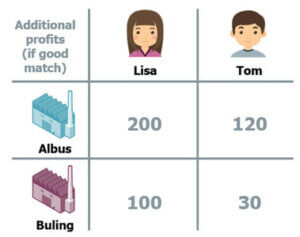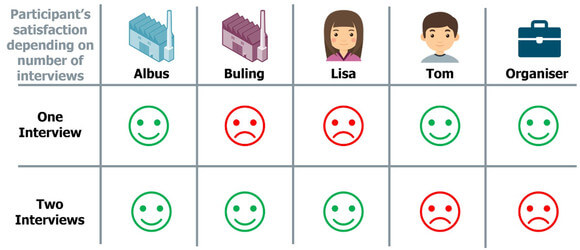In this second part of the series on strategic decisions in interviewing, the impact of the number of interviews on hiring decisions will be analysed.
In our first article, we looked at the question of when to interview. You can read the article here.
THE NUMBER OF INTERVIEWS
For our second example, we will look at the organisation of a university job fair. To keep it simple, we will assume that there are only two students, Lisa and Tom, applying for jobs, and only two companies, Albus and Buling, which are both looking for one employee each.
The job fair works as follows:
Students apply for an interview with both companies, as they have nothing to lose by sending an application, and the companies accept some of these applications. During the interview the company figures out whether the student is a good match, in which case the company makes a job offer to the student. If a student is not seen as a good match, then the company would prefer not to hire them and a job offer is not made.
Whether a student is a good match for a company can only be examined during the interview, by double-checking the qualifications listed in the CV, the impression the student gave during the interview and how they conducted themselves and answered the interviewer’s questions. The probability for a good match is 50% for each combination of student and company.
In addition, the students and companies have pre-determined preferences about the other party. One can think of this as the students’ grades and the companies’ reputation. In our example Lisa has the better grades and Albus has the better reputation. So both companies would generally prefer to hire Lisa, if she is a good match, and both students would generally prefer to work for Albus.
In the table below, it shows the companies’ expected additional profits for each combination of students and companies (if they are a good match):

The organisers of the job fair want the fair to be as successful as possible, and face the question of HOW MANY interviews to allow.
THE MORE INTERVIEWS, THE BETTER?
On the face of it, you would assume that the more interviews that take place, the better the result. However, before this assumption can be verified, we have to define what ‘better’ means. We will analyse two different measures to evaluate the results:
a) Total additional profits achieved through all job offers.
b) Number of contracts, i.e. how many students will receive a job offer.
First, we analyse the result if both students and companies can have a maximum of one interview:
As Albus is the more favoured company and Lisa is the preferred student, they will have an interview. With a probability of 50% that Lisa is a good match for Albus, the expected additional profits would be:
Expected profits for Albus interviewing Lisa: 0.5 x 200 = 100
Because each student can have only one interview, Buling will invite Tom for an interview. Again with a probability of 50% that Tom is a good match for Buling, the expected additional profits would be:
Expected profits for Buling interviewing Tom: 0.5 x 30 = 15
Therefore, the total additional profits are 115 while the expected number of job offers is 1.
In an alternative scenario, we assume that students can conduct two interviews while companies can only conduct one interview each:
The situation for Albus did not change, as they still prefer to interview Lisa over Tom and a second interview is not possible. Therefore, the expected additional profits for them remains 100, based on the 50% chance of hiring Lisa.
Buling can now either interview Lisa or Tom. As Albus is the more attractive company to both students, Buling will only be able to hire Lisa if she doesn’t receive an offer from Albus (which will happen if she is not a good match for them). If Buling decides to interview Tom, they will definitely be able to hire him because he will not receive any other offers. Nevertheless, it only makes sense to hire either student if they are found to be a good match during the interview.
Taking this rationale into account, Buling can compare the expected gain in profits of both interview options:
Expected profits for Buling interviewing Lisa: 0.5 x 0.5 x 100 = 25
Expected profits for Buling interviewing Tom: 0.5 x 30 = 15
Comparing the expected profits for Buling reveals that they will prefer to invite Lisa for an interview – even though there is only a 25% chance that they are able to hire Lisa. Therefore, the total additional expected profits of the two companies increases to 125 while the expected number of job offers decreases to 0.75.
SO HOW MANY INTERVIEWS SHOULD THE ORGANISER OF THE JOB FAIR ALLOW?
The expected additional profits would be hidden in reality, which is why organisers are typically incentivised via the number of contracts resulting from a fair – the more, the better. Therefore, the organisers would have an interest in limiting the number of interviews per student, which leads to the highest number of contracts (1 instead of 0.75).
This however, comes at the expense of both the companies and the top students: The companies, whose total expected additional profits would be higher if more interviews are allowed (125 instead of 115), and the top students like Lisa, whose chance of employment increases if more interviews are allowed (75% instead of 50%). Thus, both the companies and the top students have an incentive to convince the organisers to extend the number of interviews – as less uncertainty benefits them most in this situation.

CONCLUSION
The two models explained in our articles hopefully show that interviewing is not as trivial as it first appears, and looking at it as a strategic game can provide new insights. Recognising these patterns and using them to their advantage can create additional value to companies’ HR departments.
Title image by Christina @ wocintechchat.com on Unsplash
